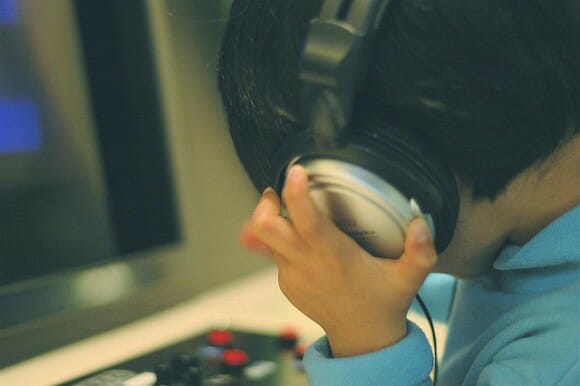Have you ever seen children wearing headphones in a therapy clinic? Did you wonder what they were doing? There’s a good chance they were using a “listening” (or “sound”) program as part of their occupational therapy. Listening programs are used in treating autism, addressing sensory, learning, and attention deficiencies, and optimizing performance.
What is a “listening program?”
Listening therapy is designed to strengthen the neurological pathways of the brain through the use of altered music, bone conduction, and movement activities.
How is the music altered?
Filters remove certain frequencies from the music. Faster frequencies have a higher pitch, while lower frequencies have a lower pitch. The filters may remove the higher frequencies, allowing the child to perceive only the middle and lower range, the lower frequencies so he can hear only the middle and higher range, or both so he perceives only the middle range.
Are the headphones special in some way?
Yes, the headphones used are very different from ones you can buy in a retail store. First, the headphones capture the entire range of frequencies used in the program. Most standard headphones can’t do that, so the child will be unable to benefit from the altered music. Second, the headphones allow bone conduction through use of a small transducer, like a hearing aid. This transducer converts the sound to vibration.
What is bone conduction? Can we hear sounds through our bones?
Yes, you can! Consider how you can “feel” the loud car beside you on the road or “feel” the beat of a bass speaker on the floor. You are hearing the music through bone conduction rather than through the air.
So is bone conduction more important than hearing sounds?
Not at all! When we hear music, our middle ear vibrates and, in turn, sends the message to our inner ear. This input then stimulates a nerve that affects our parasympathetic nervous system (PNS). Our PNS is responsible for conserving energy and completing activities such as lowering our blood pressure, slowing our heart rate, secreting digestive fluids, and improving immune function. Improvements in behavior, including decreased anxiety and increased calm, are often achieved when children use a listening program.
Why is changing sound to vibration important?
The vibration travels along the bones of the skull to the bony housing around the inner ear. This vibration causes movement of fluid in the inner ear, resulting in the activation of nerves. Many areas of the brain, including areas that affect balance, coordination, muscle tone, rhythm, and awareness of the body in space, are affected. All of these areas have a strong impact on attention and emotional regulation.
Why isn’t my therapist using this with my child? If it’s just listening it seems like it would be very easy to do.
Therapists need to be trained in the different programs in order to use them effectively. Parents need to be committed to using the program at home, as well, in order for their child to gain the greatest benefit.
How long and how often does a child need to listen?
Depending on the age of the child, the time will vary. A toddler may listen for ten minutes a day, while a teenager may listen up to an hour. A minimum of three times per week is recommended.
How do the Therapeutic Listening and Integrated Listening Systems differ?
While both programs use classical music, Therapeutic Listening also uses well known children’s songs and tunes. Therapeutic Listening provides music on CD’s or chips and uses high quality headphones that provide air conduction only.
Integrated Listening (iLs) provides their musical programs on an iPod connected to a mini-amplifier that controls the air and bone conduction. iLs also provides an option of listening through a “sound pillow” that provides both air and bone conduction through a pillow insert. This option is great for kids who do not like earphones or have issues with falling/staying asleep. Music for the sound pillow is free and can be uploaded to your phone.
How can my child gain the greatest benefit from a listening program?
She needs to follow the program recommended by her occupational therapist, which includes the sequencing of musical selections and duration and timing of listening times. In addition to listening, her therapist may suggest specific visual, balance, and movement activities in order to help strengthen neurological pathways and improve the ability to learn and process information.
Are listening programs covered by insurance?
Currently, these programs are not covered by insurance. Integrated Listening Systems does provide a rental program that allows parents to try out the equipment before purchasing.
Where do I look for further information?
To learn more about either of these programs, visit the websites linked below.
Integrated Listening (iLs)
Therapeutic Listening
If you don’t find the answers that you need, or want to speak with a certified provider for Therapeutic Listening and Integrated Listing System, give me a call here at Kid’s Creek Therapy.
Jill Ronske, Occupational Therapist
Photo Courtesy cotaro70s/flickr








